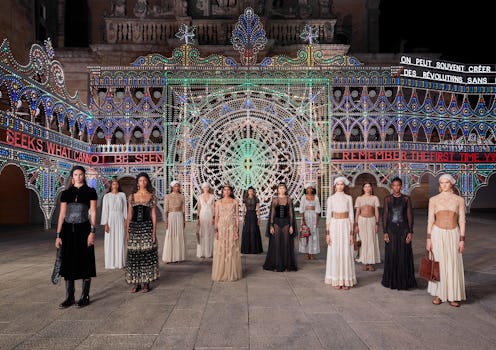(Fashion)
Dior's Cruise Collection Uses Fashion As The Conduit For Cultural Memory

For hundreds of years in Lecce, a little-known province in Puglia, its inhabitants have shared a belief in tarantism: a mystical illness caused by a tarantula bite that compels one to uncontrollably dance. Paganistic folklore is not antiquated in Southern Italy — it lives on through embodied memories, or memories passed down and conjured through physical movement. So, when Creative Director Maria Grazia Chiuri wanted to invite the world to spectate on the tradition of savoir faire in the region, it's no surprise that she summoned it through pizzica, an age-old native Puglian dance. The Dior Cruise 2021 collection focalizes the memory, history and cultural profundity of the region through unbridled movement, pulsating song, and, of course a trove of emboldened designs.
On Jul. 22, the brand's IRL show punctuated a month of virtually-rendered presentations (including its own Fall 2020 Couture collection). Onlookers worldwide streamed the presentation, which took place between the baroque walls of the Piazza del Duomo. For the occasion, Grazia Chiuri collaborated with local artisans to create luminarie — ornate, stories-high structures stenciled by colored lights — that adorned the piazza, to further illustrate the extent of savoir faire in the region. In true MGC fashion, mantras were scrawled all across the locale in beaming lights ("We Rise By Lifting Others;" "The Time For Equality Is Now"), crafting a sense of actionable urgency that the designer is known for.
The presentation started with a troupe dancing the pizzica, which summoned a throng of Dior-clad models. There were a total of 90 different looks, with color-ways coming and going in waves — from ethereal neutrals to punchier, 70s-era hues (which lent itself to the cord belts, tie-dyed trousers and bi-color woven vests). Headscarves and pastoral gowns drew inspiration from Southern Italian bucolicry; which Grazia Chiuri later rotated out for corseted evening gowns that invoked Monsieur Dior's New Look. Adorning them was "tombolo" lacework, an endangered Italian artisanal craft passed down over generations. Tombolo embroiderers use wooden bobbins to create ultra-fine, three-dimensional motifs out of lace. Familiar handbag silhouettes were given updates, including hand-carved Dior Bobby bags and resplendent Book Totes, joyfully handwoven by the Le Costantine atelier (whose motto, "Amando e Cantando," or "loving and singing," is splayed across several skirts in the collection).
By reinstating these age-old techniques of savoir faire, passed on for hundreds of years in her familial region, Grazia Chiuri reminds us that craftsmanship and cultural memory can transcend time and circumstance — so long as we are willing to pass it on.